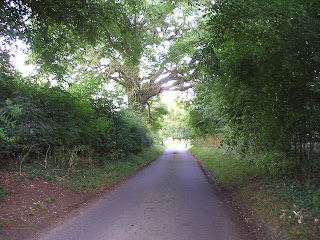Courting Ravens
Before Storm Alex hit us this weekend, bringing with it over a month’s worth of rain in less than 24 hours, the weather had been exceptionally benign. For several days the skies were clear, the sun shone and there was just enough of a cool breeze to remind you that autumn has arrived and revving up to take us into winter. In short, it was perfect conditions for walking and, so it seems, also for courting.

No, I haven’t committed to a new relationship for I’m quite happy with my old one! I’m referring to our local pair of ravens, recently joined by several others. They have taken up residence in the shelter belt of conifers, mixed softwoods and brash that stand sentinel on the ridge. From there they have a commanding view of the full length of the secret valley. On my walks, they have been chattering noisily to one another in their croaky, almost primeval sounding voice.

Whenever I hear the sound of a raven, I’m transported back to Exmoor for it was there, as a sixteen-year old, that I saw my first one. In those days (the 1960s) ravens were rarities only found in the remotest and wildest parts of the British Isles, taking refuge there after decades of persecution had exterminated them from kinder landscapes. I was resting on the heather moorland high above Farley Water, a narrow and very beautiful river valley inhabited only by sheep and the wild Exmoor ponies and red deer. Watching a black bird flying lazily along the valley far below me it suddenly body rolled and flew on its back for a few yards before righting itself to fly on until out of sight.

These body rolls, along with a wide range of acrobatic swoops and dives, are indicative of courting displays, usually seen in spring. I’m sure my lone raven in Farley Water was doing it for pure pleasure, or perhaps it was practicing them just to ensure it got it right in order to impress the gals when they appeared! Ravens do, in fact, pair for life and can live for ten years in the wild, sometimes as long as fifteen or more. This longevity, as well as the millennia they have been on Planet Earth, has given rise to many myths and traditions. Here in the UK, there is a long-held belief that if the ravens that live at the Tower of London should ever leave, both the Crown and Britain will fall to a foreign invader. They are cared for and protected by the Royal Ravenmaster of the Yeoman Warders. A much older belief common to the Abrahamic religions is that the raven was the first creature to be released from Noah’s Ark.
Ravens are now very much more common in the UK, having reclaimed much of their former territory and it is estimated that there is now well over 7,000 breeding pairs. They are also one of the most widespread of bird species being found throughout the Northern Hemisphere. It has recently been discovered, however, that when ravens colonised America those on the California coast became isolated – probably due to an Ice Age. As a result, they have evolved into a distinct race genetically, whereas the other US birds are more closely related genetically to the birds of Europe and Asia.

So how do you recognise a raven from any other black crow? Well, firstly, it’s size. It is enormous in comparison. Secondly, it’s voice which is quite distinctive once you’ve learnt to recognise it. The raven is, however, a great mimic of other sounds: twice I have been confused by the sound of a fencepost being knocked into the ground with a heavy mallet and by a small terrier dog yapping from high up in the top of a tall Scot’s Pine tree! It’s tail, if it should fly overhead, is also another way of telling it apart for it is quite diamond shaped in appearance. Finally – and not one I have seen mentioned in bird books – the wings make a distinct flapping noise much in the same way as a swan’s does. Good luck with your raven spotting and don’t be alarmed by all the stories of them being birds of ill omen. If you see one, it will make your day.



Comments
Post a Comment